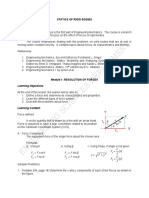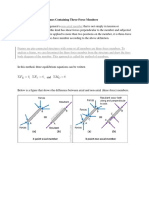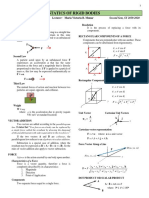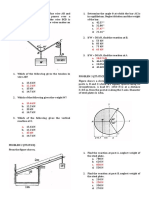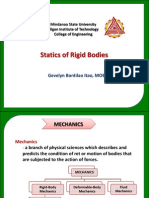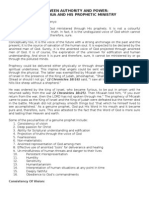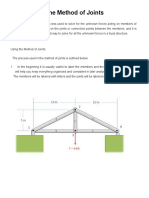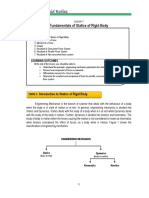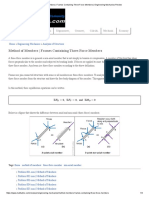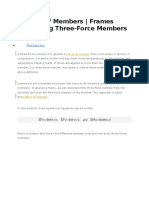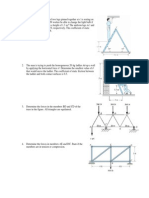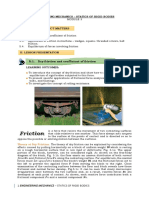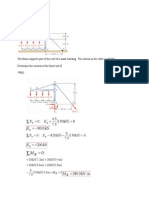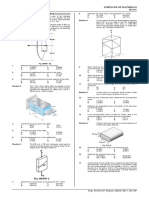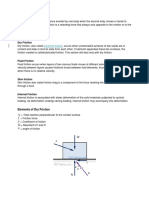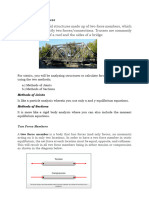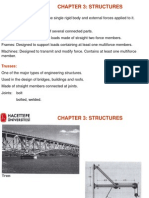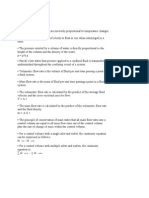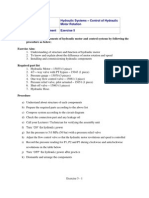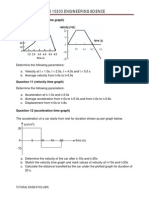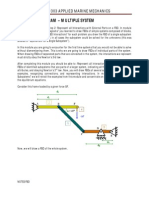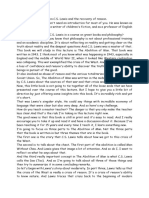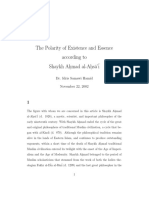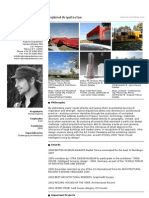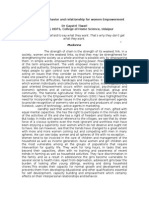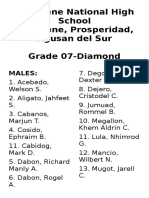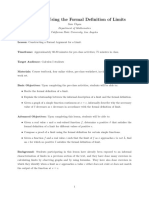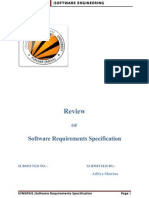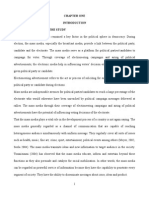Method of Sections
Method of Sections
Uploaded by
Abdul Aziz Abdul RahimCopyright:
Available Formats
Method of Sections
Method of Sections
Uploaded by
Abdul Aziz Abdul RahimCopyright
Available Formats
Share this document
Did you find this document useful?
Is this content inappropriate?
Copyright:
Available Formats
Method of Sections
Method of Sections
Uploaded by
Abdul Aziz Abdul RahimCopyright:
Available Formats
LGB 21303 APPLIED MARINE MECHANICS
METHOD OF SECTION
When one desires to find the unknown forces in only a few bars, then the method of sections is often the preferred method. This method also follows the same steps pursued in any Statics problem, but differs from the method of joints in the choice of subsystems. When applying this method we make an imaginary cut through the truss dividing it into two parts, which are referred to as sections. The cut divides some of the bars into portions, but never runs through a joint. When drawing free body diagrams of a section of the truss, we must represent the load exerted by one portion of the bar on the other portion of the bar. Since each portion must be in equilibrium, the direction and sense of that internal force is consistent with the forces exerted by the pins on the bar. The internal force is similar to the tension in a cable, except that truss members could be either in tension or compression.
EXAMPLE: Drawing and Solving for a Given Section 1 Here is the truss; only forces in bars CE and CF are to be found. All dimensions are in feet.
Each section forms a planar rigid body. In this sense it is like the 2-D subsystems considered in unit "Single Body", with three independent equations of equilibrium, for example two force equations and one moment equation. To visualize it, let us draw only the outline shape of the subsystem the section as shown below.
Do we need to analyze both sections, and/or the truss as a whole? Remember that we are interested only in forces CE and CF.
NOTES ON STRUCTURAL ANALYSIS (ABR)
LGB 21303 APPLIED MARINE MECHANICS
The left section interacts with supports and the removed portions of three bars: 6 unknowns are not solvable with only three equations. If we first determined the support reactions by analyzing truss as a whole, then the left section could be used to find the bar forces, but that would have required solving a total of two subsystems. The right section interacts only with removed portions of bars: there are 3 unknowns which are solvable with three equations. But we only want to determine 2 unknowns: CE and CF, so we may use only 2 equations, and not find DF.
Say that forces in bars EG and FG are needed. If we cut the truss as shown below, we would only have two unknown bar forces. Could the two unknown bar forces possibly satisfy three equations of equilibrium?
From the FBD, you can see that all forces pass through the joint G. So, summation of moments about that point is trivially satisfied. In fact, for this choice of cut, the method of sections is equivalent to the method of joints applied to joint G. Observation: * To form a solvable section cut through no more than 3 bars with unknown forces * In this example, the cut required to reveal the desired forces in the bars cuts the truss into two sections, such that one of them does not interact with any supports. In such cases only one subsystem (the section with no reaction forces) can be used to find the desired unknown bar forces
NOTES ON STRUCTURAL ANALYSIS (ABR)
LGB 21303 APPLIED MARINE MECHANICS
In this course from now on, for simplicity, we are going to draw the sections showing the cuts as follows;
EXAMPLE: Drawing and Solving for a Given Section 2 In this truss, all applied forces are in kN. Only forces in bars CD, IJ, and DI are to be found. Neighboring joints are separated by 3 m horizontally (e.g., A and B) and 4 m vertically (e.g., B and H).
Now you will draw the free body diagram for a section. We try to solve for the unknown forces in the bars, we find that neither section is solvable there are 4 unknowns on the left section, and 5 on the right section. Unlike with the prior EXAMPLE 1, here the whole truss has to be solved first for the tension in the cable or for the pin reactions.
NOTES ON STRUCTURAL ANALYSIS (ABR)
LGB 21303 APPLIED MARINE MECHANICS
Now both section are solvable so you could solve for the unknown bar forces, using either one of them (using both would not lead to independent equations).
Let us use the left section to find the unknowns, since it has fewer forces acting on it. As you should remember from previous modules, we try to simplify the solution process by choosing an equilibrium equation in which the desired unknown is the only unknown. For example, we could take moments about a point through which many forces pass. This moment center can be at any point, either on or off the subsystem. Observation: * The cut required to reveal the desired forces in the bars cuts the truss into two sections, both of which interact with supports. In such a case neither subsystem is solvable by itself. * Two subsystems were needed: one of the truss as a whole to find support reactions, and then one section to find the desired bar forces. We have chosen to solve the left section because it has fewer forces acting on it * It is enough to find just the unknown reaction that is on the FBD of the section chosen as the subsystem, in this example the tension T, since the left section was chosen for analysis * Note that to find IJ we use as moment center point D, a point not in the left section, since this is the point through which the line of action of the remaining two unknowns passes Summary * The section interacts with the remaining parts of the cut bars, and may also interact with supports. Commonly, the unknown forces in the bars are assumed to be in tension. * Avoid common mistakes: do not include internal forces in free body diagrams (when two connected members are both part of the subsystem, the interactions at that connection are "internal to the subsystem") * Strictly obey Newton's 3rd Law, drawing equal and opposite interactions on the two sections, in case both are drawn * Three independent equations of equilibrium can be imposed on each section, so the unknown forces in three bars could be determined from equilibrium of a section, provided that all the other forces are known (support reactions might need to be found first e.g., from the equilibrium of the whole truss)
NOTES ON STRUCTURAL ANALYSIS (ABR)
LGB 21303 APPLIED MARINE MECHANICS
Solving Truss Problems with Method of Sections You have learned how to draw the FBD for a given subsystem composed of a section of a truss, and how to solve for unknowns. Now you will need to choose cuts and subsystems to be able to solve for desired unknowns on your own. We choose a particular section as a subsystem because it allows us to determine desired unknowns in a simple way. Specifically, to choose a section we should: * cut through the bar(s) with the desired force(s) (otherwise the force does not appear in FBD) * cut through no more than three bars (otherwise the section is not solvable) If the cut required to reveal the desired forces in the bars cuts the truss into two sections, such that one of them does not interact with any supports, then only one subsystem (the section with no reaction forces) is needed to find the desired unknown bar forces. If the cut required to reveal the desired forces in the bars cuts the truss into two sections, such that both of them interact with supports, then neither subsystem is solvable by itself. We should first analyze the truss as a whole to find support reactions, and then one of the sections to find the desired bar forces. After solving for reactions, either section becomes solvable, but it is of course enough to analyze just one of them. Which one does not matter, unless more forces obviously act one compared to the other. Note also that it is not necessary to find all reaction forces. Only the unknown reactions that act on the analyzed section need to be found. Now you are going to practice problem solving on your own. However, we do provide a worked solution if you need help. In the following examples, you will practice applying the method of sections to this truss. Consider how various possible sections/subsystems can be used to determine desired unknowns. EXAMPLE: Solving Truss Problems with Method of Sections 1 Use the method of sections to find the forces in bars GI and GH of the truss shown. Attempt to do so entirely on your own.
NOTES ON STRUCTURAL ANALYSIS (ABR)
LGB 21303 APPLIED MARINE MECHANICS
The correct answers are: * GI = 211 kN (T) * GH = 83.3 kN (T) Solution to Example: Solving Truss Problems with Method of Sections 1 Here are two sections that would allow finding the desired unknowns. One could have also cut through bars GI, HI, and HJ, but those sections would have presented similar issues.
Consider these possible sections and revisit your solution earlier if it was not right. Look below for a discussion of the merits of these sections. Discussion on the merits of these sections Which section is preferable to find the forces in bars GI and GH? For Section a, one would need to find the support reactions at A and D analyzing the whole truss first. But supports do not interact with section b, so you should choose section b. To efficiently find GI, you could not use just one force summation since the other unknown forces GH and DH have horizontal and vertical components and so they would also contribute. Likewise, you could not find GH with just one force summation since GI also has a horizontal component. That leaves you with the moment summation. For a single moment equation, try to find a point through which the other forces pass, but the desired force does not. GH and DH pass through H, so it could be used to find GI. GI and DH pass through a point 3 m above K, which could be found. Moments about that point off the truss could be used to find GH.
NOTES ON STRUCTURAL ANALYSIS (ABR)
LGB 21303 APPLIED MARINE MECHANICS
Look below to see the equations used to find GI and GH. Equations used to find GI and GH
EXAMPLE: Solving Truss Problems with Method of Sections 2 Here is the same truss.
NOTES ON STRUCTURAL ANALYSIS (ABR)
LGB 21303 APPLIED MARINE MECHANICS
Use the method of sections to find the force bar FG. Attempt to solve this entirely on your own. The correct value is FG = 100 kN Tension Solution to Example: Solving Truss Problems with Method of Sections 2
Consider these possible sections and revisit your solution earlier if it was not right. Discussion on the merits of these sections Which section is preferable to find the force in bars FG? The reaction at one support appears in the FBD of each section. So, no matter which one you would choose you would have to first find reaction(s) from the analysis of the whole truss. Sections d and f only
NOTES ON STRUCTURAL ANALYSIS (ABR)
LGB 21303 APPLIED MARINE MECHANICS
have a roller support (one unknown), but they have more applied forces. Sections c and e have a pin support (two unknowns), but they have fewer applied forces. If you think ahead to what equation you would use to find FG, you would choose moments about point C for each of the above sections, since the other forces CG and CD act through C. Then, you would recognize that the horizontal reaction at pin A wont contribute anyway, only the vertical reaction will. Sections c and e have fewer forces than sections d and f. And it doesnt matter which one you choose, since both lead to the same moment equation about joint C, since the applied force of 300kN does not contribute. Equations used to find GI and GH Intend to take moments about point C, so only need vertical reaction Ay:
EXAMPLE: Solving Truss Problems with Method of Sections 3
NOTES ON STRUCTURAL ANALYSIS (ABR)
LGB 21303 APPLIED MARINE MECHANICS
Use the method of sections to find the force in bar DK. Attempt to solve this entirely on your own. The correct value is DK = 75.4 kN Compression Solution to Example: Solving Truss Problems with Method of Sections 3
Consider these possible sections and revisit your solution earlier if it was not right. Discussion on the merits of these sections Which section is preferable to find the force in bar DK? The reaction at one support appears in the FBD of each section. The horizontal reaction is obviously zero, so each support has one unknown. If we think ahead to what equation we would use to find DK, we would choose moments about point G, since the other forces DE and JK act through G. This argues in favor of section b, since the reaction at G would not contribute to the moment about G anyway. Equations used to find DK
NOTES ON STRUCTURAL ANALYSIS (ABR)
LGB 21303 APPLIED MARINE MECHANICS
EXAMPLE: Solving Truss Problems with Method of Sections 4 Consider the same truss that you analyzed in the previous example.
Find the force in bar DJ. There is no single section from which this bar force can be found. If you have some ideas, you can attempt to solve this entirely on your own. But, we will help point the way below. The correct answer is DJ = 86.7 kN Tension Solution to Example: Solving Truss Problems with Method of Sections 4 We clearly need to consider more than one subsystem (in addition to using the whole truss to find support reactions). One subsystem needs to cut through DJ. Sections c and d are such subsystems. Section c has too many unknown forces in bars, since it cuts through 4 of them. Notice that section d is equivalent to joint J there are 3 unknowns, but just 2 equations Can one of the unknowns acting on sections c or d, (besides DJ) be found from another subsystem, which in turn would enable you to find DJ from either section c or d?
If you have enough of a start to complete this problem, try to do so. If you want more discussion, continue to the section below. Discussion on the merits of these sections For Section c, if we took moments about A, then IJ and DE do not contribute, but DJ (desired) and DK do. So, we would need to find DK from a different subsystem.
NOTES ON STRUCTURAL ANALYSIS (ABR)
LGB 21303 APPLIED MARINE MECHANICS
For Section d, we could apply the method of joints to determine DJ (desired) if we knew one of the other two forces IJ or JK. So, we would need to find IJ or JK from a different subsystem. Based on the experience of the previous problems, you should be able to find a section from which to find DK (we did that before), IJ, or JK. Equations used to find DK Using Section c: After finding DK section c would become solvable. In Example 6 you saw how to find DK = 75.4 kN Compression.
Using Section d: After finding JK section d would become solvable. Using the same section b that you used to find DK in example 6, you could find JK by taking moments about D (through which DK and DE pass), but we need support reaction Gy.
You can see that the first method was more efficient, although we also need to recognize that DK was found earlier. Summary When using the method of sections: * Cut through bars with desired unknown forces * To have a solvable subsystem do not cut through more than 3 bars with unknown forces * If the cut required to reveal the desired forces in the bars cuts the truss into two sections, such that one of them does not interact with any supports, then use the section with no reaction forces to find the desired unknown bar forces * If the cut required to reveal the desired forces in the bars cuts the truss into two sections, such that both of them interact with supports, then neither subsystem is solvable by itself. Analyze the truss as a whole to find support reactions (or just those needed), and then one section to find the desired bar forces.
NOTES ON STRUCTURAL ANALYSIS (ABR)
You might also like
- Statics of Rigid Bodies The Overview: ReferencesDocument21 pagesStatics of Rigid Bodies The Overview: ReferencesNazareth Rick Otom ArcinoNo ratings yet
- Statics Rigid BodiesDocument190 pagesStatics Rigid BodiesAlexandro PenafielNo ratings yet
- Frames (Method of Members)Document16 pagesFrames (Method of Members)Rohan Sonal100% (1)
- TORQUE (Autosaved)Document24 pagesTORQUE (Autosaved)Jan Ronald Garcia PalayadNo ratings yet
- Part (A) - Force Is Applied Horizontally: AnswerDocument13 pagesPart (A) - Force Is Applied Horizontally: Answerlovebirddimple100% (1)
- Module 2 - Resultant of Force SystemDocument17 pagesModule 2 - Resultant of Force SystemErika Siosan100% (1)
- From The Truss in Fig. T-01, Determine The Force in Mebers BC, CE, and EFDocument20 pagesFrom The Truss in Fig. T-01, Determine The Force in Mebers BC, CE, and EFVince JacobNo ratings yet
- Statics of Rigid BodiesDocument31 pagesStatics of Rigid BodiesPaul Gerard Aguilar50% (2)
- Preboard Problems FinalDocument5 pagesPreboard Problems FinalAngel MarkNo ratings yet
- Statics of Rigid Bodies Chapter 1Document31 pagesStatics of Rigid Bodies Chapter 1kian1025100% (5)
- PROJECT-indian TextileDocument72 pagesPROJECT-indian TextileSowmya UsNo ratings yet
- Between Authority and Power - TB Joshua and His Prophetic MinistryDocument6 pagesBetween Authority and Power - TB Joshua and His Prophetic MinistrymattersarisingafricaNo ratings yet
- Trusses Method of SectionsDocument31 pagesTrusses Method of Sectionsclifxg100% (2)
- Chapter 2 - Supplementary ProblemsDocument11 pagesChapter 2 - Supplementary Problems김김김치No ratings yet
- Statics of Rigid Bodies Problem Sets!Document3 pagesStatics of Rigid Bodies Problem Sets!Diether RigorNo ratings yet
- Structures (Methods of Joints and Sections)Document53 pagesStructures (Methods of Joints and Sections)Edreno Olpino Jr.100% (1)
- Statics of Rigid Body - Lesson 1Document8 pagesStatics of Rigid Body - Lesson 1Lance CastilloNo ratings yet
- Methods of SectionDocument5 pagesMethods of Sectiongmailarun50% (2)
- Equilibrium of Force SystemDocument89 pagesEquilibrium of Force Systemashvy kleinNo ratings yet
- Method of Members - Frames Containing Three-Force MembersDocument75 pagesMethod of Members - Frames Containing Three-Force MembersAna May DocotNo ratings yet
- Handout 2Document31 pagesHandout 2عبدالله عبدالحكيم عامرNo ratings yet
- Method of SectionsDocument15 pagesMethod of SectionsDesti Gokil's K-AsgammaNo ratings yet
- Statics of Rigid BodiesDocument57 pagesStatics of Rigid BodiesAnna Louise Wy100% (1)
- Engg Mechanics QuestionnaireDocument15 pagesEngg Mechanics Questionnaireacurvz2005No ratings yet
- Topics Problem Set 3 - Statics of Rigid Bodies (Final) 1ST Term 2020-2021Document1 pageTopics Problem Set 3 - Statics of Rigid Bodies (Final) 1ST Term 2020-2021Franz SantosNo ratings yet
- Statics of Rigid Bodies - Fundamental ConceptsDocument4 pagesStatics of Rigid Bodies - Fundamental ConceptsJan Alexis MonsaludNo ratings yet
- Method of MembersDocument15 pagesMethod of MembersJunar AmaroNo ratings yet
- Friction T2 TestDocument5 pagesFriction T2 TestAnand BalajiNo ratings yet
- Statics of Rigid Bodies - Midterm ReviewerDocument3 pagesStatics of Rigid Bodies - Midterm ReviewerMike Millares100% (3)
- Statics of Rigid Bodies: Sample ProblemsDocument25 pagesStatics of Rigid Bodies: Sample Problemsruel_galutan67% (3)
- Theory of Structures Review NotesDocument3 pagesTheory of Structures Review NotessadonNo ratings yet
- Mechanics Problem..Document2 pagesMechanics Problem..Krissa Marie BuniagNo ratings yet
- Quiz No. 3Document2 pagesQuiz No. 3naikin_1031No ratings yet
- Es 23 CouplesDocument12 pagesEs 23 CouplesFranz ValenciaNo ratings yet
- First Assessment Exam - Correlation Ii: AB Is 2400 NDocument45 pagesFirst Assessment Exam - Correlation Ii: AB Is 2400 NAlyssa Marie AsuncionNo ratings yet
- Equilibrium of Force SystemsDocument6 pagesEquilibrium of Force SystemsJommarVocalTagalogNo ratings yet
- Flexural Stresses by The Elastic CurveDocument24 pagesFlexural Stresses by The Elastic CurveKristelle Ginez100% (1)
- StaticsDocument5 pagesStaticslakr lama100% (1)
- ES 23 ChaptersDocument92 pagesES 23 ChaptersFranz Valencia100% (2)
- Engineering Mechanics Module 3Document25 pagesEngineering Mechanics Module 3Abigail SiatrezNo ratings yet
- Statics of Rigid Bodies ManualDocument16 pagesStatics of Rigid Bodies Manualdelacruzrae12100% (1)
- Topic 7 - Vertical Parabolic Curves (Unsymmetrical)Document3 pagesTopic 7 - Vertical Parabolic Curves (Unsymmetrical)Nicholas Bonn SingNo ratings yet
- Mayas Online Mechanics Review ClassDocument23 pagesMayas Online Mechanics Review ClassVon Andrei MedinaNo ratings yet
- F.A.L. Conducive Engineering Review CenterDocument3 pagesF.A.L. Conducive Engineering Review CenterAve de GuzmanNo ratings yet
- CE 3111 Lecture Notes 3-1Document44 pagesCE 3111 Lecture Notes 3-1Kent Clark VillaNo ratings yet
- Statics of Rigid Bodies - First Term 2019: Y-AxisDocument11 pagesStatics of Rigid Bodies - First Term 2019: Y-AxisLester John Precillas100% (1)
- Solution PRELIM STHEORY 2020-2021 PDFDocument22 pagesSolution PRELIM STHEORY 2020-2021 PDFErick MangalinoNo ratings yet
- Strength Of Materials Review: α with the longitudinalDocument5 pagesStrength Of Materials Review: α with the longitudinalGee - FNo ratings yet
- 03 Trusses PDFDocument58 pages03 Trusses PDFhalder_kalyan9216No ratings yet
- Mecg of Deformable BodiesDocument25 pagesMecg of Deformable BodiesJerico Pilapil Namuco100% (1)
- FrictionDocument43 pagesFrictionIbrahim A SaidNo ratings yet
- Determinacy, Indeterminacy and StabilityDocument17 pagesDeterminacy, Indeterminacy and StabilityShepherd NhangaNo ratings yet
- Strenght of Materials (Chapter I)Document37 pagesStrenght of Materials (Chapter I)Ivy Joy BelzaNo ratings yet
- Lecture 11 - Introduction To Distributed Normal LoadsDocument30 pagesLecture 11 - Introduction To Distributed Normal LoadsLantretz LaoNo ratings yet
- Module 02: Approximate Analysis of Indeterminate Structures: Intended Learning Outcomes (ILO's)Document41 pagesModule 02: Approximate Analysis of Indeterminate Structures: Intended Learning Outcomes (ILO's)Mac KYNo ratings yet
- Module 1 - Stresses-Normal Stress, Shear Stress and Bearing StressDocument24 pagesModule 1 - Stresses-Normal Stress, Shear Stress and Bearing StressArin ParkNo ratings yet
- CE Correl 4Document90 pagesCE Correl 4Marbel PerezNo ratings yet
- TrussDocument7 pagesTrussa_j_sanyal259No ratings yet
- TRUSSDocument11 pagesTRUSSJanice RamonNo ratings yet
- Method of Joints: Members Subjected To Forces Tension and CompressionDocument7 pagesMethod of Joints: Members Subjected To Forces Tension and CompressionGemma BalictarNo ratings yet
- BME 1223Lec4LEDocument7 pagesBME 1223Lec4LEyazan alNo ratings yet
- Chapter 3: Structures: TrussesDocument19 pagesChapter 3: Structures: TrussesBadar Sharif100% (1)
- Furnace Door Control Hydraulic TaskingDocument4 pagesFurnace Door Control Hydraulic TaskingAbdul Aziz Abdul Rahim100% (1)
- Continuity Equation: Inlet OutletDocument1 pageContinuity Equation: Inlet OutletAbdul Aziz Abdul RahimNo ratings yet
- Topic: Hydraulic Systems - Control of Hydraulic Motor Rotation Type of Assessment Exercise 5Document2 pagesTopic: Hydraulic Systems - Control of Hydraulic Motor Rotation Type of Assessment Exercise 5Abdul Aziz Abdul RahimNo ratings yet
- LGB 10203 Engineering Science: Question 10 (Position Time Graph)Document1 pageLGB 10203 Engineering Science: Question 10 (Position Time Graph)Abdul Aziz Abdul RahimNo ratings yet
- LGD 10703 Engineering Science: Experiment 1: Moment of ForceDocument2 pagesLGD 10703 Engineering Science: Experiment 1: Moment of ForceAbdul Aziz Abdul RahimNo ratings yet
- FBD Multiple SystemDocument4 pagesFBD Multiple SystemAbdul Aziz Abdul Rahim100% (1)
- 1 Roles in The FamilyDocument7 pages1 Roles in The FamilyAscension VillalbaNo ratings yet
- Teaching Aptitude MaterialDocument5 pagesTeaching Aptitude MaterialAhmadNo ratings yet
- Scribd 3Document4 pagesScribd 3MirNo ratings yet
- Session Guide For Practical Research IDocument77 pagesSession Guide For Practical Research INil IrincoNo ratings yet
- Lecture - 14, C.S. Lewis The Recovery of ReasonDocument7 pagesLecture - 14, C.S. Lewis The Recovery of ReasonMaarit WilleNo ratings yet
- The Polarity of Existence and Essence Ac PDFDocument33 pagesThe Polarity of Existence and Essence Ac PDFSyed Danial ZaidiNo ratings yet
- Skin As A Performance MaterialDocument18 pagesSkin As A Performance MaterialKirsty SimpsonNo ratings yet
- Michel Rojkind HalpertDocument7 pagesMichel Rojkind HalpertFabrizio AlbertoNo ratings yet
- DR Gayatri TiwariDocument3 pagesDR Gayatri Tiwariapi-200677911No ratings yet
- ANZSCO List of OccupationsDocument854 pagesANZSCO List of OccupationsSaravanan RasayaNo ratings yet
- Mahesh Dattani's "Dance Like A Man": The Clash of Hegemonic Masculinity in India With Its OtherDocument6 pagesMahesh Dattani's "Dance Like A Man": The Clash of Hegemonic Masculinity in India With Its OtherArijit DasNo ratings yet
- JLS 714Document284 pagesJLS 714Mia SamNo ratings yet
- Reverse Engineering of Mechanical DevicesDocument4 pagesReverse Engineering of Mechanical DevicesChethan Rao HNo ratings yet
- DiamondDocument65 pagesDiamondHermann Dejero LozanoNo ratings yet
- The Soul Compass Points SouthDocument7 pagesThe Soul Compass Points SouthSveinaldr IngvarssonNo ratings yet
- Inferring Lesson PlanDocument2 pagesInferring Lesson Planapi-372342158No ratings yet
- Fazail of HindostanDocument13 pagesFazail of HindostanMalik Bilal HussainNo ratings yet
- Lesson Plan Sam ChyauDocument4 pagesLesson Plan Sam ChyauAbigael Joyce MatutinaNo ratings yet
- Review: Software Requirements SpecificationDocument13 pagesReview: Software Requirements Specificationadityasharma007No ratings yet
- How To Bring A GoddessDocument37 pagesHow To Bring A GoddessDeepak GoreNo ratings yet
- Effective Questioning and Reacting Techniques: My Performance (How I Will Be Rated)Document7 pagesEffective Questioning and Reacting Techniques: My Performance (How I Will Be Rated)Nelgen PiolaNo ratings yet
- DLR 2021 04 18 08 00Document3 pagesDLR 2021 04 18 08 00ray72roNo ratings yet
- Organizational Behavior Chapter 11Document25 pagesOrganizational Behavior Chapter 11agneslyn01100% (1)
- Chap OneDocument9 pagesChap OneOwolabi PetersNo ratings yet
- Non-Experimental Terminal Research Report Format (Sample) PreliminariesDocument4 pagesNon-Experimental Terminal Research Report Format (Sample) PreliminariesJavi GavarraNo ratings yet
- PHD OpportunitiesDocument177 pagesPHD OpportunitiesJohan BambangNo ratings yet
- Emphasis in WritingDocument6 pagesEmphasis in WritingAnila MathewNo ratings yet
